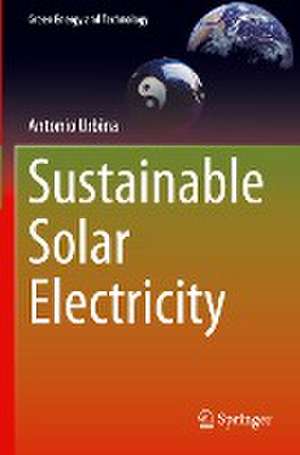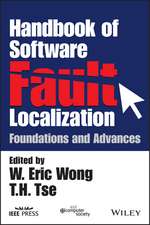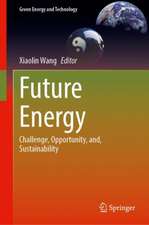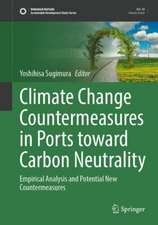Sustainable Solar Electricity: Green Energy and Technology
Autor Antonio Urbinaen Limba Engleză Paperback – 12 feb 2023
Including both commercial and emerging technologies, the book presents the energy and materials requirements to manufacture solar electricity power systems at the order of the TeraWatt scale deployment as is envisaged by the International Renewable Energy Agency (IRENA) for the near future. It discusses current manufacturing practices and how these may be adapted in the future including:
- reuse and recycling of components and materials;
- raw material supply chains to the manufacturing factories; and
- end-of-life procedures including recycling and landfilling of modules.
| Toate formatele și edițiile | Preț | Express |
|---|---|---|
| Paperback (1) | 947.11 lei 43-57 zile | |
| Springer International Publishing – 12 feb 2023 | 947.11 lei 43-57 zile | |
| Hardback (1) | 952.50 lei 43-57 zile | |
| Springer International Publishing – 12 feb 2022 | 952.50 lei 43-57 zile |
Din seria Green Energy and Technology
- 18%
 Preț: 943.43 lei
Preț: 943.43 lei - 20%
 Preț: 629.52 lei
Preț: 629.52 lei - 18%
 Preț: 1124.92 lei
Preț: 1124.92 lei - 18%
 Preț: 947.35 lei
Preț: 947.35 lei - 15%
 Preț: 655.92 lei
Preț: 655.92 lei - 18%
 Preț: 957.62 lei
Preț: 957.62 lei - 18%
 Preț: 789.52 lei
Preț: 789.52 lei - 17%
 Preț: 464.55 lei
Preț: 464.55 lei - 15%
 Preț: 645.79 lei
Preț: 645.79 lei - 18%
 Preț: 903.93 lei
Preț: 903.93 lei - 24%
 Preț: 1322.07 lei
Preț: 1322.07 lei - 18%
 Preț: 890.54 lei
Preț: 890.54 lei - 18%
 Preț: 1115.46 lei
Preț: 1115.46 lei - 18%
 Preț: 1117.03 lei
Preț: 1117.03 lei - 18%
 Preț: 949.73 lei
Preț: 949.73 lei - 18%
 Preț: 892.11 lei
Preț: 892.11 lei - 15%
 Preț: 648.24 lei
Preț: 648.24 lei - 18%
 Preț: 997.09 lei
Preț: 997.09 lei - 15%
 Preț: 579.81 lei
Preț: 579.81 lei - 18%
 Preț: 1123.15 lei
Preț: 1123.15 lei - 18%
 Preț: 961.41 lei
Preț: 961.41 lei - 17%
 Preț: 490.22 lei
Preț: 490.22 lei - 18%
 Preț: 904.60 lei
Preț: 904.60 lei - 15%
 Preț: 643.34 lei
Preț: 643.34 lei -
 Preț: 287.90 lei
Preț: 287.90 lei - 24%
 Preț: 634.04 lei
Preț: 634.04 lei -
 Preț: 379.39 lei
Preț: 379.39 lei - 18%
 Preț: 783.20 lei
Preț: 783.20 lei - 18%
 Preț: 1394.84 lei
Preț: 1394.84 lei - 18%
 Preț: 1691.57 lei
Preț: 1691.57 lei - 18%
 Preț: 1112.48 lei
Preț: 1112.48 lei - 15%
 Preț: 592.61 lei
Preț: 592.61 lei - 18%
 Preț: 952.09 lei
Preț: 952.09 lei - 18%
 Preț: 944.19 lei
Preț: 944.19 lei - 18%
 Preț: 891.33 lei
Preț: 891.33 lei - 18%
 Preț: 1252.44 lei
Preț: 1252.44 lei - 18%
 Preț: 789.52 lei
Preț: 789.52 lei - 20%
 Preț: 566.29 lei
Preț: 566.29 lei - 18%
 Preț: 1113.71 lei
Preț: 1113.71 lei - 18%
 Preț: 1114.24 lei
Preț: 1114.24 lei - 24%
 Preț: 590.58 lei
Preț: 590.58 lei - 20%
 Preț: 567.49 lei
Preț: 567.49 lei - 24%
 Preț: 907.48 lei
Preț: 907.48 lei - 18%
 Preț: 952.89 lei
Preț: 952.89 lei - 18%
 Preț: 952.89 lei
Preț: 952.89 lei - 18%
 Preț: 950.52 lei
Preț: 950.52 lei
Preț: 947.11 lei
Preț vechi: 1155.01 lei
-18% Nou
Puncte Express: 1421
Preț estimativ în valută:
181.23€ • 189.70$ • 150.84£
181.23€ • 189.70$ • 150.84£
Carte tipărită la comandă
Livrare economică 31 martie-14 aprilie
Preluare comenzi: 021 569.72.76
Specificații
ISBN-13: 9783030917739
ISBN-10: 3030917738
Pagini: 301
Ilustrații: XVI, 301 p. 67 illus., 64 illus. in color.
Dimensiuni: 155 x 235 mm
Greutate: 0.49 kg
Ediția:1st ed. 2022
Editura: Springer International Publishing
Colecția Springer
Seria Green Energy and Technology
Locul publicării:Cham, Switzerland
ISBN-10: 3030917738
Pagini: 301
Ilustrații: XVI, 301 p. 67 illus., 64 illus. in color.
Dimensiuni: 155 x 235 mm
Greutate: 0.49 kg
Ediția:1st ed. 2022
Editura: Springer International Publishing
Colecția Springer
Seria Green Energy and Technology
Locul publicării:Cham, Switzerland
Cuprins
Part I: Introduction.- Scenarios for Solar Electricity at the TeraWatt Scale.- Photovoltaic Technologies.- Assessment of Sustainability.- Part II: Life Cycle Assessment of PV Modules: From Cradle to Gate.- Production of PV Modules.- The Limits of Raw Materials.- Energy Use in the Production Routes.- Impacts of PV Module Manufacture.- Part III: life Cycle Assessment of PV Systems: From Gate to Grave.- Use Phase and Lifetime of PV Technologies.- Recycling and End-of-Life of PV Technologies.- Balance of Systems and Storage.- Logistics of PV Systems in a Global Market.- Part IV: Beyond Life Cycle Assessment: Socioeconomics and Geopolitics of Solar Electricity.- Socioeconomic Impacts of Solar Electricity.- Overview of Standardization and Regulation for PV Technologies.- Solar Electricity and Globalization: Competing in the Electricity Market.
Notă biografică
Professor Antonio Urbina is working at the Institute for Advanced Materials and Mathematics (INAMAT2) and the Department of Sciences (Public University of Navarra, UPNA, Spain). He has been working on the development of solar photovoltaic systems for more than 20 years, many of them at Technical University of Cartagena (UPCT, Spain). Starting from his Ph.D. studies on electronic transport in III-V semiconductor devices, he has worked on the physics of solar cells for several photovoltaic technologies, running from commercial Silicon to GaAs to emerging organic and hybrid photovoltaic technologies in collaboration with international research centres such as Imperial College London, Technical University of Denmark and several Spanish universities and research centres. He has also worked on the deployment and evaluation of photovoltaic systems both in large grid-connected plants and in small stand-alone systems for rural electrification in developing countries suchas México, Guatemala and Cuba (for which he received the Prize of the National Academy of Sciences in Cuba in 2018 in collaboration with Universidad Central “Marta Abreu” de Las Villas, Santa Clara, Cuba). For several years, he has focused on the development of life cycle assessment methodologies to be applied to commercial and emerging photovoltaic technologies in order to evaluate the environmental impacts and possible bottlenecks to its massive deployment. He has published more than 60 scientific articles in international journals, has participated in several conferences and is a member of international scientific advisory committees at large research facilities such as Institute Laue Langevin (ILL, France) or ISIS neutron spallation source at the Rutherford Appleton Laboratory (UK).
Textul de pe ultima copertă
This book provides a detailed life cycle assessment of photovoltaic technologies in order to analyse the environmental and socioeconomic impacts that a large deployment of solar photovoltaic systems will produce in the near future.
Including both commercial and emerging technologies, the book presents the energy and materials requirements to manufacture solar electricity power systems at the order of the TeraWatt scale deployment as is envisaged by the International Renewable Energy Agency (IRENA) for the near future. It discusses current manufacturing practices and how these may be adapted in the future including:
Including both commercial and emerging technologies, the book presents the energy and materials requirements to manufacture solar electricity power systems at the order of the TeraWatt scale deployment as is envisaged by the International Renewable Energy Agency (IRENA) for the near future. It discusses current manufacturing practices and how these may be adapted in the future including:
- reuse and recycling of components and materials;
- raw material supply chains to the manufacturing factories; and
- end-of-life procedures including recycling and landfilling of modules.
Caracteristici
Presents the life cycle assessment of emerging photovoltaic technologies Discusses the environmental and socioeconomic impacts of solar electricity Explores how to make solar energy technologies more sustainable






















